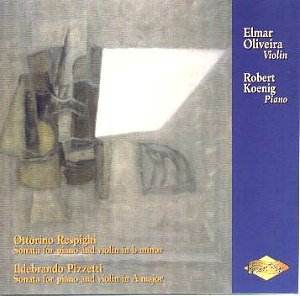In the liner notes to this satisfying disc Elmar Oliveira
mentions that two recordings inspired his interest in the sonatas of
Respighi and Pizzetti – those, respectively, by Heifetz and Menuhin.
It reflects something of the house style of Artek, who encourage their
artists to link performance with recollection of past recordings and
musicians. It’s true though that these two violinists were very closely
associated with the sonatas – after Menuhin in 1938 no one returned
to the Pizzetti until Rasonyi and Ertungealp on Marco Polo in 1994.
Oliveira and Koenig mark the third recording. The Respighi has been
taken up on occasion by many great musicians but great recordings are
fewer on the ground - I have soft spots, apart from Heifetz, for Josef
Suk (who recorded it twice, firstly with Panenka in 1953 and then with
Hála in 1980) and a trio of Americans - Rosand, Shumsky and Kaufman.
In the Wartime Respighi – the Pizzetti was written
two years later – a contemporary of Ireland’s A minor sonata, we feel
the turbulent and kinetic drama of a violinist-composer writing in
media res. The obsessive and occasionally violent aggression of
the contours of the violin line encourage great depth of tone fro Oliveira
(he digs deep into the G string) and he maintains a consistently virile
and inflected series of shapings. His soaring lyricism is projected
and maintained with considerable distinction and his playing in the
higher positions is, with his double-stopping, commendable. Curiously
I was reminded in passing moments of Elgar’s almost contemporaneous
Sonata. The slow movement opens with the piano’s delicate tracery, the
violin soaring aloft with effortless ascent and becoming subsequently
obsessive and unsettled and agitated. Oliveira conveys a communing depth
and dignity as the movement continues, Robert Koenig’s rapport an indissoluble
component in the movement’s success, the burgeoning not untroubled lyricism
affecting. The Passacaglia finale undoes all that. Stern and remorseless
passagework takes the work in an altogether different direction before
Respighi introduces and develops some quirky little rhythmic games between
violin and piano, some lyrical and some effusive. The work ends in a
spirit of stoical decisiveness, well conveyed by Oliveira and Koenig.
Written at the end of the First War the Pizzetti opens
pensively with the violin above a hypnotic, haunting and repetitious
piano line. A deeply expressive second subject emerges which manages
to sustain poetic and lyric intensity at a relatively slow tempo. Indeed
the ability of both men successfully to gauge the elasticity of the
line here is excellent. The meditatively vocal quality of the beautiful
Preghiera second movement is given added plangency by the little unsettled
intensities of the piano left hand. Oliveira plays this movement with
a veiled, smoky tone. Contrasted with the interior intensity of this
movement’s prayer for the dead is the finale’s fluttering and dancing
vivacity (marked Vivo e Fresco), which is broadly consolingly optimistic,
though it still finds time for some occasional hints of loss in its
fabric of dance-like exultation.
This is a splendid survey of Italian Great War sonatas.
It gives renewed life to the Pizzetti, a work that deserves far more
than an occasional hearing, and joins fine company in the Respighi.
Fine production values here from Artek, despite the relatively poor
playing time, and a strong recommendation for the performances.
Jonathan Woolf

